Michael Wallick - 27th Indiana Infantry, Co. B
Place of enlistment: Daviess County,
Service Time: 3 years
Born:
Height: 5'8" black hair, gray eyes
Civilian occupation: Farmer
Michael, son of "Bunker Hill" Michael, son of "Bedford" Michael, Son of Hans Michael and Esther Wallick
Michael Wallick, c. 1904
 On a warm August afternoon in 1861, Michael Wallick, age 44, left his wife, his five children (ages 6 to 18) and his Indiana farm to go into the little
On a warm August afternoon in 1861, Michael Wallick, age 44, left his wife, his five children (ages 6 to 18) and his Indiana farm to go into the little
Michael was born in
The 1850’s saw an explosion in regional conflicts between the North and South. Slavery was an open sore that had festered for many years in the United States and it aggravated all other points of disagreement between the two factions. With the passage of the Fugitive Slave Law, Kansas-Nebraska Act, and John Brown’s raid on Harper’s Ferry, southern
In this titanic national struggle, “Uncle Mike” (as he was called by his comrades) saw action in both the western and eastern theaters of the war. In the spring of 1862 he and his regiment were part of the Union's effort to defeat Stonewall Jackson in the Shenandoah Valley. In the process, Michael was wounded and captured at Buckton Station and then experienced the hell of a Confederate prison for three months. While Michael was in prison his regimental brothers took part in the bloodiest day of battle in American history, the Battle of Antietam. There his regiment sustained heavy casualties in "The Cornfield." Michael was released from prison in September of 1862 and helped the Union Army avoid disaster the following spring at the Battle of
Journey of the 27th Indiana Infantry during the Civil War
(map from A History of Daviess County)

Michael Wallick with the 27th
Michael and the men of Company B, 27th Indiana, assembled on this field in August of 1861 before marching off to war . The park is located on Co. Rd. 1000 N. in Raglesville.
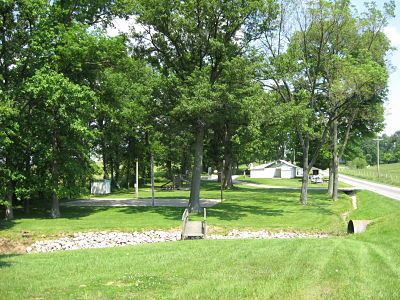
1862
JAN - FEB The regiment continues to be active in northern Virginia and Maryland. They also help guard the Baltimore & Ohio Railroad and its junctions.
MAR-JUN Stonewall Jackson's Shenandoah Valley Campaign The 27th
MAY 23 Engagement at Buckton Station- Michael is wounded and becomes a POW. Michael’s company and one company from the 3rd Wisconsin Infantry are sent to Buckton Station to prevent the Confederates from disrupting railroad and telegraph communications between Front Royal and
The Manassas Gap Railroad crossing at Buckton Station as it appears today.
Michael was captured near this spot on May 23, 1862.

MAY 24-SEP 12 Michael becomes a POW and is first taken to
The following account is from Wilbur D. Jones’s book, Giants in the Cornfield:
“Corporal Michael Wallick, sliced in the shoulder by a saber at Buckton, was never treated. He had ‘a sponge and much cold water applications and kept down the pus and it healed all right.’ Wallick, one of the few Hoosiers imprisoned at Lynchburg, Libby and Belle Isle, (all in
Another account of his capture is from James E. Garten’s book Clarksburg and Early Odon, Indiana
“In one skirmish, Mike Wallick, Andrew J. Vest, and Bob Shears of the 27th regiment were captured (at Buckton Station). The ‘Rebels’ wanted to shoot Wallick because they said he had killed their general. (No general was involved in the engagement, however, two confederate captains were killed during the fight. Michael may have killed one of them). His fellow prisoners knew that he did it, for ‘Uncle Mike’ was a fine shot. After a long and heated argument they finally made the ‘Rebels’ believe that the man who did the killing had escaped. The three were imprisoned at Belle Isle. The food was bad, as in all other rebel prisons. Wallick and Vest said that while they sickened on the food, Bob Shears, who had been reared in the slums of Cincinnati, got fat. It was better than he had been accustomed to at home.”
SEP 13 Michael is paroled at Aikens Landing, Virginia. On that same day, three of Michael’s comrades from company B find a copy of General Robert E. Lee’s “Special Orders #191” wrapped around three cigars in an abandoned field outside of Frederick, MD. These lost orders from General Lee to his corps commanders tell General McClellan of the movements to be carried out by the Army of Northern Virginia for the next four days. This knowledge helps produce a great Federal victory at
SEP 17 Battle of
SEP 18 Michael is finally exchanged and begins his return trip to his regiment.
OCT–DEC The 27th Regiment has guard duty from Harper's Ferry to
1863
JAN 20–24 "The Mud March" The regiment participates in General Burnside’s disastrous “Mud March”. In December the general had been humiliated by his defeat at Fredricksburg, VA. To right the reversal General Burnside plans a winter offensive (against the wishes of his subordinates) and will attack the rear of General Lee's army in order to destroy his supply line. Two days of unseasonably warm weather and heavy rains turn the Virginia dirt roads into a quagmire. The Army of the Potomac becomes paralyzed in knee-deep mud, making movement impossible. This is the last straw for President Lincoln and the bungling General Burnside is relieved of command.
MAR 13 Michael is promoted to 1st Sergeant.
MAY 2-3 Battle of
Michael and the 27th Indiana bravely withstand a crushing evening attack made by General Jackson’s Corps at the end of the first day of battle. This helps forestall a Federal panic and collapse. The repulse of this late day charge, together with the next morning's counterattack at
For the next three hours the 27th Indiana's brigade counters numerous Confederate attacks and only withdraws after they have exhausted their supply of ammunition. The brigade is then moved to the rear and off the front line of battle. By midday the whole Federal Army has to retreat due to the poor decisions made by the Union high-command. The numbers alone tell the story of the fierce fighting Michael's regiment sees at the Battle of Chancellorsville. On May 1st there are 300 men present for duty. Two days later 36 men have been killed and 114 wounded, a casualty rate of fifty-percent.
This monument to the 27th Indiana Infantry is located between the battlefields of Hazel Grove and Fairview. The regiment fought here on the night of May 2nd and the morning of May 3rd. During this engagement they sustained heavy losses.

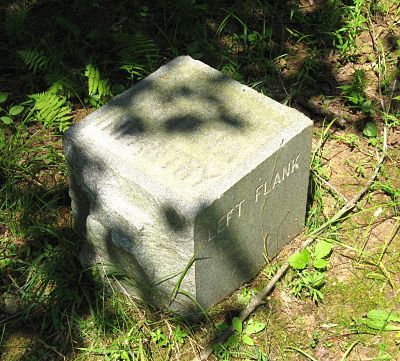
Two small granite stones mark the exact location of the 27th Indiana Infantry's left and right flanks.
The monument below is positioned between the two flank markers.

The monument reads:
The 27th INDIANA INFANTRY
3rd BRIGADE, 12th CORPS
HELD THIS POSITION FROM 7 PM
MAY 2nd TO 9 AM MAY 3rd 1863
PRESENT FOR DUTY 300
KILLED 36, WOUNDED 114
MUSTERED IN AUG. 1861
MUSTERED OUT SEPT. 1864
TOTAL ENROLLED 1,101
KILLED 172, WOUNDED 505
DIED OF DISEASE, 120
Looking from Fairview to Hazel Grove where Michael and the 27th Indiana were deployed at Chancellorsville. Hazel Grove is approximately one mile in the distance, at the end of the open ground. The monument to the 27th Indiana is on Paxton-Berry Road, which runs through the woods to your left and parallel to the battlefield.

JUL 1–3 Battle of Gettysburg. The 27th Indiana is involved in a controversial early morning attack at Gettysburg. Most people are familiar with General Pickett's tragic charge that was made on the last afternoon of the three-day battle. Michael's regiment will also make a hopeless and disastrous charge on the third day of battle and will suffer the same end result as General Pickett. Many men of the 27th will be needlessly butchered due to a misunderstanding of orders and an aggressive colonel demonstrating his fighting spirit.
First Day of Battle- The 27th Indiana has been marching all day from Littlestown and arrives at Gettysburg at about 4:00 PM. They spend the night near Wolf Hill and receive orders to form and entrench the next day at the base of Culp's Hill.
Monument to the 27th Indiana
at the base of Culp's Hill
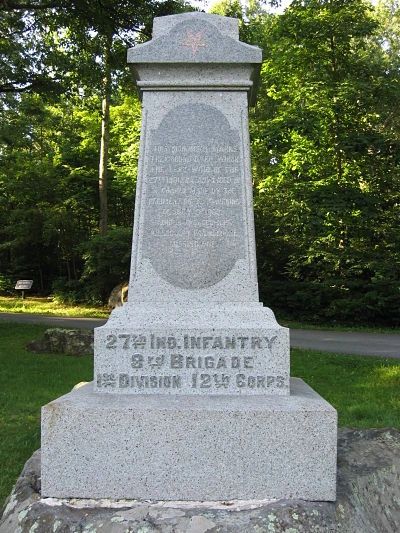 Second Day of Battle- 8:00 AM Michael and his regiment march to Spangler's Spring at the base of Culp's Hill and they become the extreme right of the Union Army at Gettysburg. In the morning, skirmishers from the 27th have a long-range duel with the famed Stonewall Brigade. The regiment spends the day entrenching at their new position near Rock Creek. At 6:00 PM the regiment is ordered south toward Little Round Top to help bolster that position, which has been under heavy attack all day. As they march toward their assigned position near the Wheatfield they are exposed to artillery fire. There are only a few casualties. After 45 minutes they are ordered to counter-march back to their original position at Culp's Hill. When they return they find that the Confederates have taken their old position and occupy the breastworks. The men are furious that the Rebels now benefit from their hard day's labor and want to retake the works immediately, but they must wait until the next morning.
Second Day of Battle- 8:00 AM Michael and his regiment march to Spangler's Spring at the base of Culp's Hill and they become the extreme right of the Union Army at Gettysburg. In the morning, skirmishers from the 27th have a long-range duel with the famed Stonewall Brigade. The regiment spends the day entrenching at their new position near Rock Creek. At 6:00 PM the regiment is ordered south toward Little Round Top to help bolster that position, which has been under heavy attack all day. As they march toward their assigned position near the Wheatfield they are exposed to artillery fire. There are only a few casualties. After 45 minutes they are ordered to counter-march back to their original position at Culp's Hill. When they return they find that the Confederates have taken their old position and occupy the breastworks. The men are furious that the Rebels now benefit from their hard day's labor and want to retake the works immediately, but they must wait until the next morning.
Third Day of Battle- 5:00 AM. The 27th Indiana's brigade and regimental commander, Colonel Colgrove, receives orders to advance two regiments across the swale (or meadow) and retake the Union position that was lost the preceding day. What was actually ordered has been disputed and a controversy about the orders arose immediately after the battle. Colonel Colgrove insisted that the officer from headquarters who communicated the orders to him demanded that two regiments from his brigade cross the swale and retake the entrenched position. General Ruger, the commanding officer at headquarters, remembers Colonel Colgrove being ordered to "advance skirmishers at that point (the swale) and, if not found in too great a force, to take two regiments and dislodge the Confederates from the breastworks." By not advancing skirmishers first (to test the strength of the Rebel works) the 27th Indiana and 2nd Massachusetts march into a suicide attack. Colonel Colgrove writes:
"the enemy was entirely sheltered by the breastworks and ledges of rock. It was impossible to send forward skirmishers. The enemy's advantages were such that a line of skirmishers would be cut down before they could fairly gain the open ground that intervened. The only possible chance I had to advance was to carry the position by storming it."
Confederates fired at the 27th Indiana from behind breastworks (represented below by the stone wall) which the Indianans had constructed the previous day to use against the very enemy that now possessed them. The 27th Indiana and 2nd Massachusetts charged across open ground to the right of the picture.
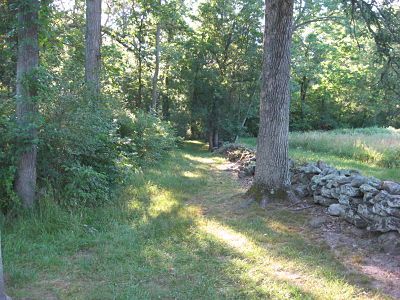
Below is "The Swale" where the 27th Indiana and 2nd Massachusetts of Colonel Colgrove's brigade charged at Confederate breastworks on the morning of July 3, 1863. There are three Indiana monuments in this picture. The monument that is in the shade and to the left is to the 27th Indiana Infantry. The tall memorial to the right is dedicated to all Indiana regiments who fought at Gettysburg. Between those two memorials is a small stone marker that shows the farthest advance made by the 27th Indiana before retreating. This picture is taken from the Confederate perspective. The Hoosiers advanced out of the left woods near the regimental monument and charged toward the camera. The Swale at Spangler's Spring is stop #13 on the Gettysburg National Park Battlefield Auto Tour.

The Confederates outnumber the Federals two to one in this attack. Lt. Colonel Charles Mudge of the 2nd Massachusetts Infantry, upon receiving his orders asks, "Are you sure that is the order?" The orderly answers in the affirmative. Lt. Colonel Mudge then says, "Well, it is murder, but that's the order." He does not survive the charge. It is said that Colonel Colgrove, upon receiving his orders, is dismayed but cool. He pulls on his nose, which he does when pondering a difficult problem, and repeats, "It cannot be done; it cannot be done." Pausing and looking upward he then says, "If it can be done, the 2nd Massachusetts and the 27th Indiana can do it."
Michael's regiment first has to make a complex marching movement to begin the charge. In the first 100 yards the 27th maneuvers down a slope that is thickly covered with oak and hickory saplings. They then pick up the pace as they enter the clearing of the swale. A Confederate volley decimates the men of the 27th but the survivors merely close ranks and continue. The fire grows more intense and the two regiments have to fall back and retreat to there own breastworks. Immediately the Rebels mount an ill-conceived counterattack that is easily beaten back by the 27th Indiana and 2nd Massachusetts. For the rest of the day the troops must remain under a boiling hot sun amidst the groans of the wounded and decaying bodies of the dead.
The monument below indicates the farthest point advanced made by the 27th Indiana in its attack at The Swale. The Rebels fired behind breastworks at the bottom of the tree line.
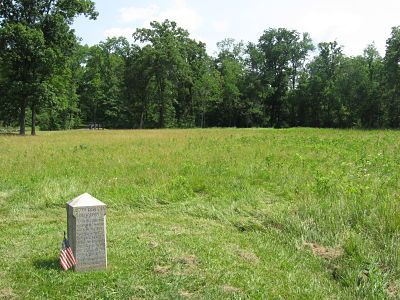
Four color bearers were killed and four more wounded in the attack.

The 27th Indiana and 2nd Massachusetts lose 38% of their men in the assault at "The Swale" of Spangler's Spring. Tactically, little is accomplished in this attack. However, the charge does force a realignment of the defending Confederate forces, leading to a late- morning Union victory on Culp's Hill. Colonel Colgrove, known to enjoy the attack, is accused of exceeding his orders when he makes the charge at The Swale, but General Ruger defends the Colonel and officially concludes that it was an honest misunderstanding of orders. Here at Culp's Hill, on this last morning of battle, Union and Confederate forces are engaged in continuous combat for approximately seven hours, the longest sustained action at the Battle of Gettysburg.
OCT 3-30 Michael is home on furlough most of the month and returns to duty November 1st.
NOV-DEC. The 27th is moved the the western theaterof the war and guards the Nashville & Chattanooga Railroad at
1864
JAN–APR Preparations for the
MAY 4-The
MAY 14-15 Battle of

MAY 27 Michael is admitted to Jefferson County General Hospital in Louisville, Kentucky, for treatment of the wound he received at the Battle of Resaca.
JUN 28- AUG Sergeant Wallick is moved to Madison Medical Hospital in Madison, Indiana, for recuperation from his hip injury.
SEP 1 Michael reports back for duty in the field. He has missed the final push to and siege of Atlanta with his regiment, but will be with them at the conclusion of the regiment's service.
SEP 2 Atlanta surrenders and the Confederate Army evacuates the city.
SEP 12 Michael is mustered-out of Federal service at Camp Morton, Indianapolis and returns to Daviess County, Indiana.
Michael returned to Daviess County after being discharge from the 27th Indiana and two months later his eighteen-year old son, William Huette, enlisted in the army. Jane Wallick, Michael's wife, lost a husband for three years to the war then loaned a son to the conflict (see the William "Huette" biography). Michael became a charter member of his local *G.A.R. Post #474 in Raglesville, Indiana.
*(
By 1900 Michael had retired from farming and was living in Oden, Indiana. He died on February 13, 1905 and is buried with his wife, Jane, in the Raglesville, Indiana, Cemetery.
Sergeant Michael Wallick of the 27th Indiana Infantry, 1817-1905
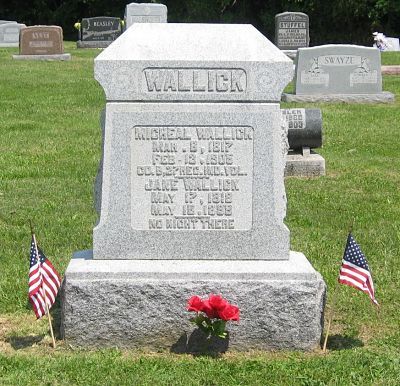
Comrades-in-Arms
Son
William Huette 38th IN
Cousins
Daniel 20th OH
David 139th OH
Elijah 102nd OH
Henry 67th OH
David H 102nd OH
Song- Battle Cry of Freedom
Return to Top
Return to
Wallick Family Website
